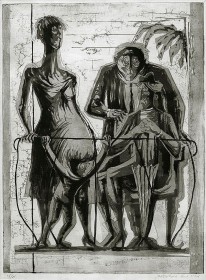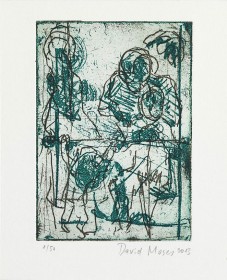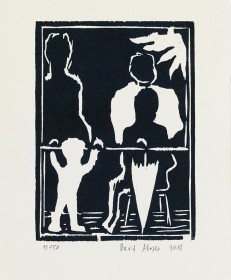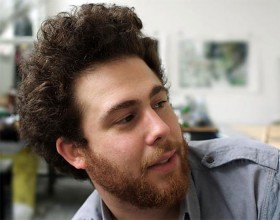The construction and the fall of the Berlin Wall have occupied two generations of artists in the Moses family: in 1963/64 Manfred Heinz Moses created “The Balcony,” an etching on which, fifty years down the line, his grandson David Moses was to base a woodcut and polychrome etching. The latter works are likewise called “The Balcony” and they number among the unique pieces developed by seven artists resident in Berlin for the art vending machine on display in our permanent exhibition. A total stock of 1,400 artworks has been sold since early summer.
Grandpa Moses created his etching when still reeling from the shock of a trip to Berlin shortly after the Wall was built. It shows
a seemingly resigned family, standing on a balcony.

“The Balcony” (1963/64), etching by Heinz Manfred Moses (1917–1982) ©
The Moses Family, photo: David Moses
The artist and lecturer Manfred Heinz Moses was born in Marienwerder, East Prussia, in 1917 and migrated to Palestine in 1937. When his kibbutz gave him a grant to study at the Amsterdam Academy of Art in 1963/64, he seized the chance to visit the divided city, too.
His 31-year-old grandson David Moses now lives as an artist in Berlin. He manages the artistic legacy of Manfred Heinz, which is the only means he has ever had to get to know him. I interviewed David about why he had based his work for the art vending machine on his grandfather’s Berlin motif. He told me: “I believe the division of Germany deeply affected my grandfather and he expressed this in an unusual way. Without background info, one would never know the family in the etching is standing on a balcony in East Berlin. And yet the image evokes a disturbing and oppressive atmosphere.”

“The Balcony. 2013.DG.TD.13.9.0001”, David Moses, Color etching from two plates in an edition of 50, 2013 © Jewish Museum Berlin, photo: Jens Ziehe
David works primarily as a painter and printmaker, following in his grandfather’s footsteps. In his art, he explains, he explores “past traces and fragments in space.” And looking at his abstract images makes this patently clear: the interplay of colors, structures and layers lends his works a novel depth and timelessness. Yet there is also something palpable, immediate and vibrant about them. In comparison, the work of Heinz Manfred Moses is much more realistic. “These are incredibly good etchings. He worked quite differently than I do. In only a few strokes, he brought objects and people to life, created something hugely expressive.”

„The Balcony. 2013.DG.HD.13.9.0001”, David Moses, Woodcut in an edition of 150, 2013 © Jewish Museum Berlin, photo: Jens Ziehe
For the art vending machine David chose to make his own interpretation of a family in the divided Berlin. Unlike in his grandfather’s work, the figures here vanish almost beyond recognition. In particular the many fine lines and intricate details in Heinz Manfred’s artwork posed a challenge for David when developing his woodcut. He created several versions and was satisfied only with the fourth. For the print he made ten plates, then experimented with various color combinations and sequences. When commissioned to produce work for the Jewish Museum Berlin, he settled finally on two plates: one with only sketchy outlines and, by way of contrast, a more figurative one.
On 9 November 1989, David was only 6-years-old. Nonetheless, the fall of the Berlin Wall has left a deep impression on him. “I’ve lived in Berlin for eight years now and the 9 November is always a special day for me, year after year.”
Stephanie Alberding, Press and Public Relations
